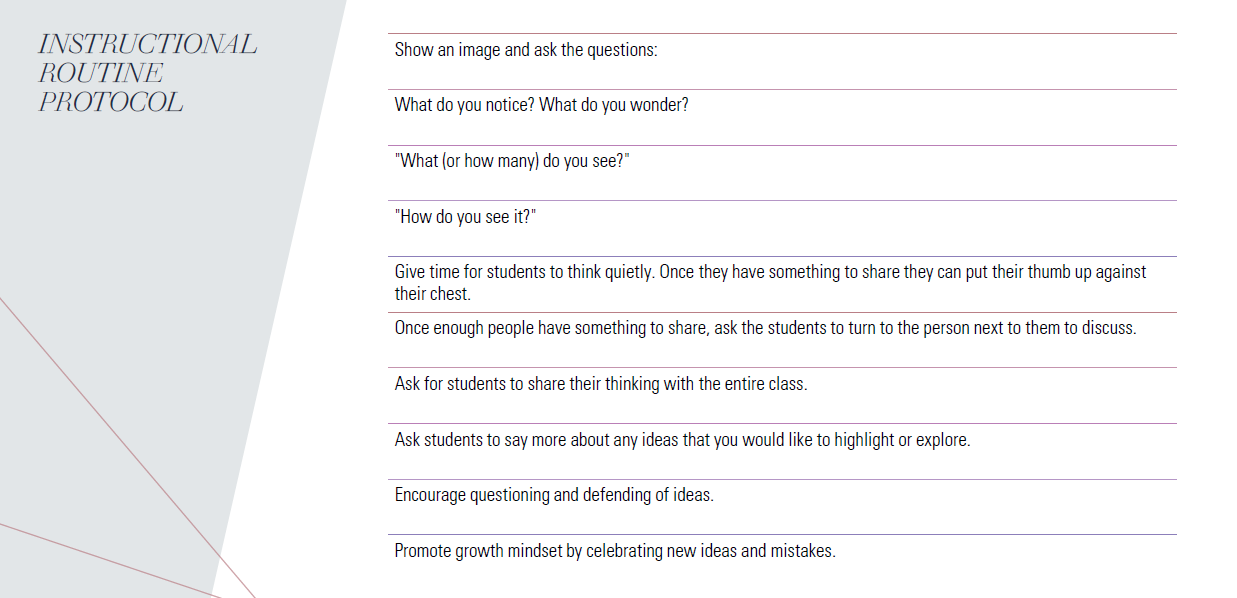Instructional Routines
Math is everywhere! We have been using great online resources in our classrooms as routines. When students become familiar with a routine, they learn to navigate their learning because of its predictability. This predictability provides access to learning for all students. With a routine, the instructions are similar, or remain the same, and students can focus on the provocation or task – they can focus on their thinking about the math!
Instructional Routines support curricular competencies across math strands. These provocations can be used as short ‘math talks’ that follow a common discussion framework where the teacher takes on the role of facilitator and students share their reasoning and strategies with one another. Routines and provocations provide an opportunity:
- to include regular practice of foundational numeracy concepts
- to build a community and culture of learning
- to focus on noticing and listening, and being responsive to students’ understandings and reasoning
- to provide a focus on the curricular competencies
A discussion framework might look like this:
Collection of Resources
| Website | Link | Description | Prompting Questions |
| Number Talk Images | http://ntimages.weebly.com/photos.html | Images, dots and number strings to use with number talks |
|
| Would You Rather? | http://www.wouldyourathermath.com/ | Provides students with two options, both of which require basic computation, comparing value, etc. |
|
| Splat! | http://www.stevewyborney.com/ | Dot formations with part-unknown including Spats through 10 and 20, multiple splats, fraction splats and variable splats! |
|
| Fraction Talks |
| Simple visuals to foster creative thinking around fractions |
|
| Same or Different |
https://samedifferentimages.wordpress.com/
| Provocations that provide opportunity for students to learn how to talk about various features of mathematical objects such as quantity, shape, color, orientation, and arrangement.
|
|
| Solve me Mobiles |
https://solveme.edc.org/Mobiles.html
| Supports algebraic reasoning in a fun and interactive format, elementary-secondary. |
|
| Visual Patterns | Visual Patterns - 1-20 | As students build, play, colour code and describe patterns, they build their ability to think about patterns in flexible ways. Working with visual patterns allows students to see authentic connections between concrete patterns and their symbolic representations, such as tables and graphs. Visual Patterns – Mathing Around
|
|
| Cube Conversations | Cube Conversations - Steve Wyborney's Blog: I'm on a Learning Mission. | Develops visualization and subitizing, thinking about the number of cubes that make up the structure |
|
| 3 Act Tasks |
http://blog.mrmeyer.com/category/3acts/
| Math tasks that consist of three parts: Act One: a provocation, such as a picture and a question; Act Two: a video with further information; Act Three: the reveal. Students discuss their questions and reasoning with one another throughout each act. |
|
| Estimation 180 | Estimation 180 – Building Number Sense | Estimation and reasoning skills, justifying thinking. |
|
| Estimation Clipboard | The Estimation Clipboard - Steve Wyborney's Blog: I'm on a Learning Mission. | Develops estimation strategies by showing new information in each slide. Students practice reasoning, visualizing, and explaining their mathematical thinking in partners and with the class. |
|
| Between 2 Numbers |
http://www.between2numbers.com
| Middle school investigations for proportionate reasoning |
|
| Array Chats | https://onedrive.live.com/view.aspx?resid=665A7678364788F3!150&ithint=file%2cpptx&authkey=!AL0kwFGwJ5mF0yg | Photos of arrays around the home to use for number talks |
|
| Numberless Word Problems | https://numberlesswp.com/ | Helps students to infer and to better understand the underlying structure of word problems. |
|
| Slow-Reveal Graphs | - Slow Reveal Graphs | Scaffolded visuals to help students make sense of data |
|
| Graphing Stories | | STEM | Video Provocations that students graph |
|
| Math Visuals | https://mathvisuals.wordpress.com/ | Helps students visualize math concepts and also shows how students can create their own visuals |
|
| Clothesline Math | Clothesline Math – The Master Number Sense Maker | A manipulatable number line activity where students use benchmark numbers to compare and order values and discuss their reasoning. |
|
| Menu Math | Menu Math – Beyond the Algorithm | Students create a mathematical object that satisfy a list of constraints. |
|
| Open Middle | https://www.openmiddle.com/ | Using the numbers 1-9, one time only, students fill in the blanks to make the equations true. |
|

